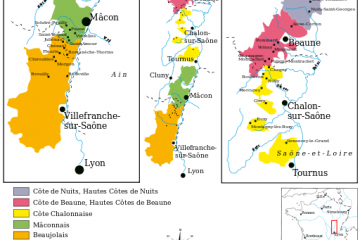Wine tourism is a seriously popular pursuit. Every year, wine lovers from all over travel near and far to visit wineries, vineyards, museums and other wine destinations. There are tons of such destinations throughout Europe and the rest of the world, so there is no shortage of places from which to choose.
Some top European destinations include Rioja, Champagne and Bordeaux. Further afield, there are must-see regions like Napa Valley in California and Marlborough, New Zealand. You could literally spend your entire life travelling the world’s wine regions and still not see them all.
If that sounds tempting, you’re in luck: In this guide, we’ll give you everything you need to organise your very own wine tour, anywhere in the world!
Deciding where to go
First things first: Where would you like to visit? This is entirely up to you, and will depend on your own preferences, budget and geographical location. Ask yourself a few questions and things will become clear quickly enough!
Where do you want to go?
This one might seem obvious, but it’s important. Visit the wine region that makes your favourite wines, and avoid places whose wines you don’t like.
Advocates of Albariño should probably be looking at Rias Baixas, while champions of Chenin Blanc should head for South Africa or the Loire Valley. That sort of thing.
Of course, there’s not much sense in visiting Jerez de la Frontera or Porto if you can’t stand fortified wines!
What’s your budget?
It’s important to be realistic here. Some wine tours will cost more than others, dramatically so in some cases. Part of this will come down to expenses like travel and accomodation, but there’s more to it as well.
Some regions are more expensive than others.
- Want to visit high-end California wineries? Bring your cheque book. Many tasting rooms charge for admission, often substantial amounts. You’ll probably have your fees waived or discounted if you buy some wine, but that’s another expense, too.
- Champagne is relatively expensive to visit, especially if you opt for some of the more prestigious houses or tour options. Lunch in the vineyard or blending your own Champagne sounds pretty good, but be prepared to hand over hundreds or even thousands or euros for the privilege!
- By comparison, you might find that visiting small family properties in Burgundy or elsewhere will considerably cheaper, if not free to visit. Of course, the wines tend to cost a small fortune, so there’s that…
If money is no object, fine. Plan all the winemaker dinners, overnight château stays and helicopter rides that you like. These things don’t come cheap though, so be warned! It pays to do your homework and look at different options before deciding on a place to go.
Where do you live?
Location matters. If you live in the north west of Spain and like fine red wines, consider somewhere like Rioja or even Bordeaux. If you’re in the UK and like sparkling wines, there are plenty of vineyards in England, though you could certainly make the short trip to Champagne, too. If you live on continental Europe, many excellent wine regions are easily accessible by car, train or plane. Do a bit of research and see where you’d like to go first.
How to book a wine tour
Broadly speaking, you have two options here:
-
Book your tour through a licensed wine tour operator.
The benefits here include the experience and expertise that these companies have, the relationships they have with top wineries and the fact that they will take care of most of the tricky parts for you, leaving you to enjoy yourself. The primary downside is that this can be something of an expensive option.
-
Make all the arrangements yourself.
Book flights, rent cars and accommodation and everything else, and more importantly: Book your own winery visits. On the plus side, you are your own boss and the schedule is up to you. If you’re flexible about travel dates and have an eye for a bargain, this can be a much cheaper option. On the other hand, booking winery visits is not always the easiest thing for a member of the public to do. Some regions are better than others for this, though even within regions there will be some variation.
What you need to know
Every region is different, but there are a few rules of thumb that will be useful no matter where you go.
-
Book winery visits in advance, where possible.
This will guarantee that you will actually be let inside, and often will give you more choice when it comes to different packages available. Certain packages may require advanced planning or preparation, and simply won’t be possible if you just show up on the day. Some top wineries have very long waiting lists, too, so keep that in mind.
-
Do your research.
Look up individual regions, wine tour operators and wineries on Google or TripAdvisor. Learn from others’ mistakes!
-
Mind your language.
Wine tourism is global. If you’re visiting a foreign country and don’t speak the local language, do a little planning in advance. Most Bordeaux châteaux will have some English speakers on hand, smaller Burgundy domaines may not. Knowing some basic phrases certainly won’t hurt, though in some cases it may be necessary to hire an interpreter or bilingual tour guide to join you.
-
Drink responsibly.
Wine tasting is fun, for sure, though a full day of tasting measures can add up. Wineries provide spittoons, don’t be afraid to use them!
-
Make suitable transport arrangements to and between wineries.
Most wine regions are in rural areas, which may be poorly served – if at all – by public transport. You may need to rent a car or hire a driver of some sort. Keep in mind that you may want to buy wine from individual wineries, so be sure you have somewhere to transport it too. Remember to never drink and drive.
-
Be realistic in your expectations
Some regions and producers love to welcome tourists, some less so and some not at all. Don’t be disheartened, the wine world is big and most people in it are very welcoming. And just to save you the trip: No, Domaine de la Romanée Conti probably won’t let you in!
[cta_generico id=2584]


